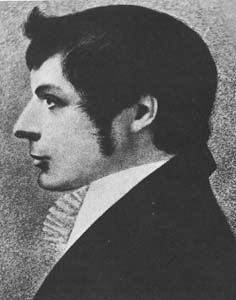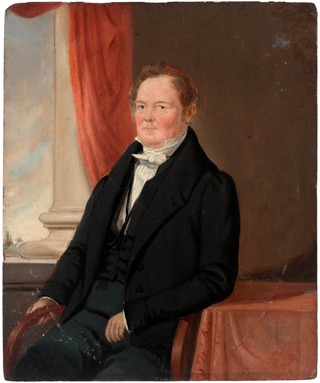| |||||
| Decades: | |||||
|---|---|---|---|---|---|
| See also: | |||||
The following lists events that happened during 1817 in Australia.
| |||||
| Decades: | |||||
|---|---|---|---|---|---|
| See also: | |||||
The following lists events that happened during 1817 in Australia.

John Joseph William Molesworth Oxley was an explorer and surveyor of Australia in the early period of British colonisation. He served as Surveyor General of New South Wales and is perhaps best known for his two expeditions into the interior of New South Wales and his exploration of the Tweed River and the Brisbane River in what is now the state of Queensland.

Major General Lachlan Macquarie, CB was a British Army officer and colonial administrator from Scotland. Macquarie served as the fifth Governor of New South Wales from 1810 to 1821, and had a leading role in the social, economic, and architectural development of the colony. He is considered by historians to have had a crucial influence on the transition of New South Wales from a penal colony to a free settlement and therefore to have played a major role in the shaping of Australian society in the early nineteenth century.

George William Evans was a surveyor and early explorer in the Colony of New South Wales. Evans was born in Warwick, England, migrating to Australia in October 1802.

John Thomas Bigge was an English judge and royal commissioner. He is mostly known for his inquiry into the British colony of New South Wales published in the early 1820s. His reports favoured a return to the harsh treatment of convicts and the utilisation of them as cheap agricultural labour for wealthy sheep-farming colonists. Bigge's reports also resulted in the resignation of Governor Lachlan Macquarie whose policies promoted the advancement of ex-convicts back into society.
The following lists events that happened during 1810 in Australia.
The following lists events that happened during 1811 in Australia.
1813 in Australia featured a number of important developments. Gregory Blaxland, William Lawson and William Charles Wentworth crossed the Blue Mountains which opened up the interior of New South Wales for European settlement. John and Elizabeth Macarthur sent the first wool exports from their properties.
The following lists events that happened during 1812 in Australia.
The following lists events that happened during 1814 in Australia.
The following lists events that happened during 1815 in Australia.
The following lists events that happened during 1816 in Australia.
The following lists events that happened during 1818 in Australia.
The following lists events that happened during 1819 in Australia.
The following lists events that happened during 1822 in Australia.

Thomas Davey was a New South Wales Marine and member of the First Fleet to New South Wales, who went on to become the second Lieutenant Governor of Van Diemen's Land.

Joseph Lycett was a portrait and miniature painter, active in Australia. Transported to Australia for forging banknotes, Lycett found work in the colony as a painter specialised in topographical views of the major towns of Australia, and some of its more dramatic landscapes.
Anthony Fenn Kemp was a soldier, merchant and a deputy judge advocate of the colony of New South Wales. He was one of the key participants in the "Rum Rebellion" that removed William Bligh, the appointed governor of the colony, and established an interim military government. He was later permitted to settle in Van Diemen's Land and became a successful merchant and farmer there.

Fort Macquarie was a square castellated battlement fort built in 1798 at Bennelong Point, Sydney, New South Wales, Australia, on the site where the Sydney Opera House now stands. It was demolished in 1901 to make way for the Fort Macquarie Tram Depot.

Thomas Laycock was an English soldier, explorer, and later businessman, who served in North America during the War of 1812, but is most famous for being the first European to travel overland through the interior of Tasmania.

European land exploration of Australia deals with the opening up of the interior of Australia to European settlement which occurred gradually throughout the colonial period, 1788–1900. A number of these explorers are very well known, such as Burke and Wills who are well known for their failed attempt to cross the interior of Australia, as well as Hamilton Hume and Charles Sturt.